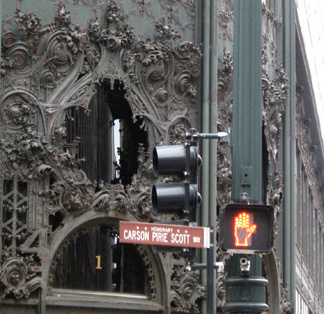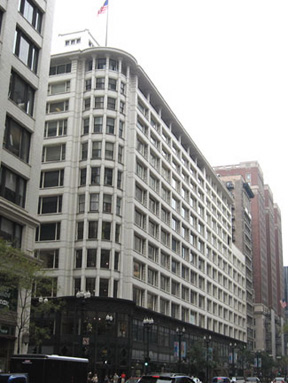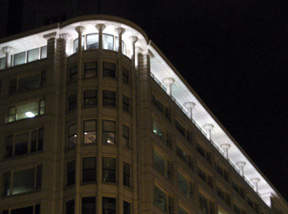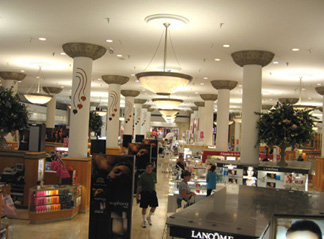Repeat- Writings on Architecture: - End of the Road (original) (raw)
Broadway may the "fabulous invalid", but the department store has been at death's door longer than many of us have been alive. Still, it was a shock when, last Friday, parent company Bon- Ton Stores, Inc. made a sudden announcement that Carson, Pirie Scott, housed in a Louis Sullivan masterpiece on Chicago's State Street for over a century, would be euthanized sometime early in 2007. I feel almost like I'm living in the last movement of Gustav Mahler's Sixth Symphony. First the hammer blow of Marshall Fields' turning into a Macy's, now this - if things start to quiet down again, I'll still be cringing in anticipation of what will be the third, final coup de grace.
Ton Stores, Inc. made a sudden announcement that Carson, Pirie Scott, housed in a Louis Sullivan masterpiece on Chicago's State Street for over a century, would be euthanized sometime early in 2007. I feel almost like I'm living in the last movement of Gustav Mahler's Sixth Symphony. First the hammer blow of Marshall Fields' turning into a Macy's, now this - if things start to quiet down again, I'll still be cringing in anticipation of what will be the third, final coup de grace.
I'll be writing a lot more about this, and about the journey of Chicago's State Street from one of the world's greatest shopping venues to a a diminished collection of discounters and outlet stores, when Federated rebrands Marshall Fields in Macy's colors as its new local flagship next month, but for now here's a few random thoughts and what's going on and where we might be heading.
1. Reading and listening to all of the analysts reporting and consultants pontificating underscored how most are little more than a cross between Pangloss and Polonius. No matter what happens, they, of  course, saw it coming, it was inevitable, and it will ultimately prove a very positive thing. One can't take in their endless choruses of Que Sera, Que Sera without thinking how anathema they were - and are - to just everyone who has ever built a great institution, from the original Marshall Field, to Stanley Marcus, Sam Walton and James Sinegal. Today's consultants seem like the courtiers of medieval times, disdaining original thought in favor of the sure thing of telling their patrons what they think they want to hear.
course, saw it coming, it was inevitable, and it will ultimately prove a very positive thing. One can't take in their endless choruses of Que Sera, Que Sera without thinking how anathema they were - and are - to just everyone who has ever built a great institution, from the original Marshall Field, to Stanley Marcus, Sam Walton and James Sinegal. Today's consultants seem like the courtiers of medieval times, disdaining original thought in favor of the sure thing of telling their patrons what they think they want to hear.
- Forget sick. Department Stores could be dead within a decade. Not only have they failed to figure out where they fit in with current consumer habits and tastes, but the efforts of many of the most storied chains have been sabotaged by long periods under surrealistically unfit parents who had no idea what they needed to be doing, and even less interest. Marshall Fields spent a long portion of its sad recent history owned by a tobacco company. It would take Montgomery Ward's a couple more decades to die, but its fate was sealed when it inexplicacy became a part of Mobil Oil. When department stores are run by people whose expertise is
 in leveraged buyouts and real estate plays rather than merchandising, the march to the gallows is in full gallop. The fact that department stores have been considered a troubled business for decades didn't stop chains from massively overpaying for the stores they acquired. Bon-Ton Stores cited increasing costs and declining sales as key reasons for closing Carson's on State Street, but servicing the massive amount of debt it took on after it spent over a billion dollars purchasing 300 stores, include Carson's, from Saks inevitably narrowed the window of tiime they had to find a solution.
in leveraged buyouts and real estate plays rather than merchandising, the march to the gallows is in full gallop. The fact that department stores have been considered a troubled business for decades didn't stop chains from massively overpaying for the stores they acquired. Bon-Ton Stores cited increasing costs and declining sales as key reasons for closing Carson's on State Street, but servicing the massive amount of debt it took on after it spent over a billion dollars purchasing 300 stores, include Carson's, from Saks inevitably narrowed the window of tiime they had to find a solution.
3. And what of Carson's iconic State Street building?. According to reports, floors three and above will converted to offices, with the lowest two preserved for retail use. The stewardship of Joseph Freed and Associates, which recently bought the structure, has been beyond reproach. They've just spent millions  restoring, under preservation architect Gunny Harboe's direction, Sullivan's original recessed top floor arcade and cornice, complete with richly ornamented soffits and columns. It had been missing for over half a century. The current store spreads across most of a full city block. Most of the interiors, especially on the non-Sullivan Wabash side of the block, are eminently disposal. The same is not true, however, for the State Street side, with its soaring quarter-block open sales floor, set amidst a sea of columns topped by ornate Sullivan-designed capitals.
restoring, under preservation architect Gunny Harboe's direction, Sullivan's original recessed top floor arcade and cornice, complete with richly ornamented soffits and columns. It had been missing for over half a century. The current store spreads across most of a full city block. Most of the interiors, especially on the non-Sullivan Wabash side of the block, are eminently disposal. The same is not true, however, for the State Street side, with its soaring quarter-block open sales floor, set amidst a sea of columns topped by ornate Sullivan-designed capitals.
Early speculation has talked of dropped ceilings, of Trader Joes or even a Target. Bringing those stores to State Street would be a great idea, but not for the great northeast sales floor of Carson's. If Joseph Freed covers up Sullivan's capitals and carves the space up into the usual rabbit warren of individual, dry- walled shops, or, God forbid, turns it over to cheap metal shelving and shopping carts, they'll go from saints to goats in a blink of an eye. Which leads me, at least for now, to conclude with this final point:
walled shops, or, God forbid, turns it over to cheap metal shelving and shopping carts, they'll go from saints to goats in a blink of an eye. Which leads me, at least for now, to conclude with this final point:
4. Despite the mindless pronouncements of the civic spin doctors, the loss of Carson's does matter. Letting State Street descend into just another subset of kind of cubicled, cookie-cutter chain stores that can be found everywhere else trashes Chicago as a whole. Field's and Carson's weren't generic - they were the people's palaces. Their splendid architecture and public spaces reflect this. Challenges notwishstanding, they represent Chicago's real "edge" over its suburban rivals. A great city has things like these; a gulch of strip malls does not. They've got, in spades, the kind of real character the currently in-vogue "lifestyle" centers work overtime to fake, with usually pallid results.
These two great buildings remain an indispensible reminder that that there's more to life than spending increasing portions of our time depersonalized into a consuming-widget-in-a-warehouse. Big box retailers have proven they can bring people of all income levels and races together, just like the department stores once did, but they do little to build community or a satisfying urban experience. Christmas at Field's can still evoke feelings of deep emotion. The closest I've ever heard anyone talk that way about Christmas at Target or Wal-Mart is when they're got a great story about how quickly they got out of the parking lot.
More later.
Join a discussion on this story.
© Copyright 2006 Lynn Becker All rights reserved.